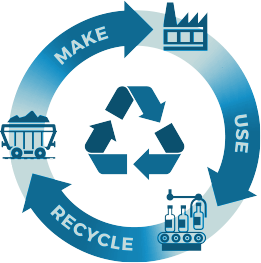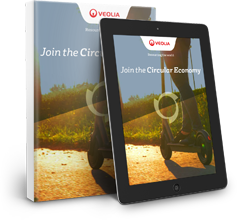
What is the circular economy?
The circular economy is a solution for industry and business at all scales to reduce, reuse and recycle waste. This solution extends beyond reducing trash in landfills, reusing products and recycling plastics.
The circular economy aims to turn all wastes into a resource by reintroducing them into the production cycle instead of product disposal at the end of their useful life. The circular model is based on three principles:
- Design out waste and pollution
- Keep products and materials in use
- Regenerate natural systems
EXPLORE THE
BENEFITS
Download our FREE Circular Economy eBook to learn how it can benefit your business.
What is a linear versus circular economy?
Most production processes in the United States follow a linear "take-make-waste" approach, which has caused significant damage to our living environment over the years. With the strain on our natural resources, this outdated linear model is unsustainable.

Within a circular system, products are designed to be re-manufactured for new uses or the materials recovered and made into new products. By re-thinking how we produce, consume and extend the life of finite resources, materials can be recycled or leveraged further in a continuous flow, generating resource savings, protecting supplies, maintaining materials at their highest value and reducing carbon footprint.
By shifting our economic models from a linear into a circular economy, we can help turn "take-make-waste" into "made to be made again."


Why the circular economy is important
Our world is supplied with finite resources. While these resources regenerate, they are doing so at a slower rate than we as a population are extracting them. Many of those finite resources are becoming scarce — clean drinking water, quality soil, natural gas, minerals, precious metals, and more. In the past forty years, annual global extraction of materials has tripled.
By 2050, the total demand for resources is expected to reach 130 billion tons, up from 50 billion in 2014, a 400% increase.
By applying a circular economy model, companies can help contribute to the replenishing of Earth's natural resources while simultaneously extracting more value out of existing materials and resources used in daily operations. Additional benefits include:
- Save money and improve price stability across your entire supply chain
- Pioneer change within your industry, satisfying changing customer needs and shifting markets
- Stay ahead of government regulations and new requirements
- Empower your employees with a message of positive change
- Gain customer loyalty and improve your brand recognition
What are the economic impacts of a circular shift and how is this implemented?
By leveraging circular models, companies, cities, and governments are preserving resources to promote growth, create jobs, protect and extend the life of supplies, and reduce carbon footprint. Implementing a circular approach requires professional skills in resource management and the impetus to do so.
Meeting sustainability goals and reducing impact to the planet
78% of S&P 500 companies issued sustainability reports in 2018. 95% of these reports offered environmental performance metrics, while 67% set time-intensive environmental goals tied to their performance metrics. These numbers indicate a stark shift in corporate thinking, as companies have started to commit to circular practices that drive value creation.
Cost reduction and resource efficiency
Cost savings and operational efficiencies are direct incentives to implement circular initiatives ( i.e. creating a return on investment or new sources of revenues from a service model that extracts the maximum value of resources).
Consumer demand
The increased environmental awareness of consumers has prompted major brands to make voluntary commitments toward disclosure/ transparency of the supply chain. As a result, companies need to think not only about their source of energy but how their products are made and used.
Environmental Policy and Regulation
Resources are finite and the population is growing. There is no question that more efficient use of resources must go into effect. Organizations can gain a competitive advantage by leading their industry in circularity to appear socially responsible to the public. Starting early allows for more time to develop an optimal plan for the circular transition in the face of increasing regulation.

Circular Shifts Mitigate Risk
While many companies have made the transition to a circular model, a majority of companies still operate linearly. By doing so, these companies not only miss the chance to realize the benefits outlined above, but they become more susceptible to the risk factors associated with linearity. Companies operating under this model tend to follow certain business practices, which focus on the prioritization of sales, the utilization of cheap, non-renewable resources, and a failure to collaborate in partnerships that are beneficial to the industry and society. These practices date back to the start of the Industrial Revolution, a time period that assumed a constant, economically viable supply of natural resources for the future. As we know, this is no longer the case. What does this reality mean for these outdated business practices? Increased risk.
Generally, these risks are divided into four major risk factors: market, operational, business and legal. All of these have the ability to hamper a linear business, but under different circumstances:
Market Risks
Market risks can be significant depending on the supply and demand of certain resources. Trade wars or supply shortages could cause major economic implications.
Operational Risks
Operational risks, such as failures within the supply chain, have the ability to disrupt a company’s work process, and therefore its economic output.
Business Risks
Business risks can arise as a result of emerging societal and political trends. Consumer awareness has started to shape consumer demand, prompting brands to make certain commitments and changes to satisfy its customer base.
Legal Risks
Legal risks arise from the failure to comply with regulations and standards. As government regulations tighten in the face of climate change, companies will face increased costs to meet regulations, or increased fines for failure to act.
The circular economy model provides solutions to mitigate linear risks such as these. Not only that, but these circular shifts often turn into a competitive advantage for companies. According to a 2017 WBCSD publication, 80% of companies surveyed cited accelerating growth or enhancing competitiveness as the primary driver for circulare strategies. Only 20% recognised risk mitigation as a value driver for moving towards a more circular model. In order to recognize these advantages, you must know how to successfully apply the circular economy to your business.

Applying the Circular Economy to your Business
When implementing circular concepts into your business plan there are certain tipping points that greatly affect the success of adoption.
Let the data drive decisions
All company structures and processes are different, each with unique opportunities to maximize efficiency and reduce waste through evaluating current resource use and applying one or more circular concept to their current process. Collect all relevant production data to gain a more holistic view of what and how resources are used in your company's processes.
Consider All Forms of Circularity
The circular economy can present in many forms - its ever-evolving and a profound opportunity for creative applications of circular concepts to make an impact on not only cost savings but also our planet’s limited resources. Resource recovery, sharing models, product life extension, service as a product model, and circular supplies models all manifest circularity in different ways.
Engage Stakeholders Early
Identify both the primary and secondary stakeholders. By what parameters will the shift to circular processes be evaluated? It’s likely that your company already has goals around sustainability, but what overarching changes can be considered? These conversations must engage top stakeholders early as they will be critical in seeing the initiative through.
Consult with Experts
Research, conversation, and due diligence are all critical processes in the transition to a more circular business model. Environmental service companies can be useful in helping to gather the right data and see potential solutions in a new light. While there are endless combinations of circular activity, finding the right processes to implement can be challenging.
Circular Economy for Water
Climate change and population growth have put burgeoning demands on our water sources, making responsible water management a necessity. Water-stressed areas require increasing regulation which has led both industry and municipalities to seek more efficient and cost-effective use.
Despite the same circular goals, though, the different situational uses for water and different sources of wastewater require unique treatments and specific standards of effluent quality.
As our awareness of environmental impact grows, each of us can play a role in conservation, reuse, and regeneration of the natural resources we have.
In Municipal Use
As urban populations increase, so does the amount of municipal wastewater produced. While some local governments may see this as a burden, others have seen this as an opportunity to recover resources through creative and sustainable closed loop tactics. Biosolids and residuals programs that extract maximum value from wastewater to produce reusable byproducts can help cities achieve their circular economy goals. Reclaimed resources such as compost, fertilizers, and biofuels can offset operational costs, reduce the amount of sludge sent to landfills, replace the use of chemical fertilizers, and limit the use of non-renewable energy sources.
In Industrial Use
The amount of water needed for production processes and the resulting wastewater are critical factors in a multitude of industries. Not only is water use and wastewater management financially significant, but also environmentally sensitive. In the past, traditional business models have been linear in nature, embodying a “take, make, waste” structure. However, our growing global population will eventually exceed our limited supply unless we make the shift to circularity.
Every production system needs to actively seek out changes that can be made to become more circular in resource use. In many of the manufacturing processes, water functions as an input element. For instance, it is used to generate steam to churn a turbine engine, which in turn, generates electricity. You’ll also find water used as a cooling agent, whether at large refineries or at office buildings.
The oil and gas industry faces unique challenges as it reaches for sustainability goals while providing energy for our communities. In an oilfield five times the amount of water is produced for every single barrel of oil that comes out of the ground. All of this water can be reused in a variety of ways: reused in the production process treated for surface discharge, or treated and reused as process water.
Whatever the method, the goal is the same: produced water should not end there, but rather go on to find a new purpose, value, and function in this world of limited resources.
After production, the crude moves on to be processed in a refinery. Oil is extracted and oily sludge is the byproduct. Once it was considered a waste stream only appropriate for landfill/deep well injection. Today through technical innovations, additional oil can be extracted along with salvageable water and other valuable resources.

The Circular Economy for Waste
The circular economy is a set of standards and practices that expands beyond industry, for all industries inevitably produce a waste stream. Even in daily life by correctly recycling your old iPhone, waste is ever-present, ever-growing, and critical to be managed responsibly.
Environmental regulations of the late 1970s and early 80s sought to protect the environment by prescribing management methods for the first time. The world of waste was split in two, the non-hazardous waste of EPA’s Subtitle D and the hazardous waste of Subtitle C. These laws imposed new costs on businesses and industry who responded by reducing the volume and toxicity of their waste in an effort to reduce cost.
Today we have a mature production process that has harvested the low hanging fruit. However, there are gains to be made by applying the concepts of a circular approach to formerly linear processes.
Rethinking the Idea of Waste
In the video, "waste" is now viewed as a material with inherent value. For non-hazardous waste, this means examination for opportunities for segregation to allow higher value recycling of valuable components that were once commingled. This total waste management approach takes a holistic view of materials. Potential outcomes of this approach is the adoption of zero waste to landfill goals and potentially the achievement of the holy grail, zero waste.
Hazardous waste can be evaluated through the same model. At the top of the chain is beneficial reuse, sale or trade on secondary material markets or other use in kind opportunities. Segregation of mixed waste is the next step, and while it may be more work, it yields material that is more easily recyclable or of a higher value. Solvent wastes are prime candidates for deeper evaluation of segregation opportunities and subsequent recycling.
Many wastes generated by industry are not recyclable, but hold high heat value because of their composition. This material is often a candidate for use as a substitute for fossil fuels in the production of cement. Many waste types can be blended for fuel, and this process is beneficial to the environment versus treatment.
It's not just organic waste that can be recycled. Many inorganic materials lend themselves to recycling as they are elements. Lead batteries, electronic, lighting and plating are all examples of items that can be recycled at end of life. These contain precious metals that can be reclaimed and utilized in a closed loop system.
Spotlight on Medical Waste Disposal
Over the last 30 years, the disposal of medical waste has gained the attention of the public and government agencies at the state and federal level. In 1994, the EPA released a Dioxin Reassessment that identified medical waste incineration as the single largest source of dioxin air pollution. This created a path to autoclave technology, which utilizes steam to disinfect the waste before disposal, eliminating the hazardous threat to human health and the environment.
Today, the landscape has changed further to include more environmentally friendly options like ozone technology that can be used in concert with the concept of fuel blending. The resultant medical waste can now produce energy and not be landfilled, a sustainability win-win.
Use
In the prior diagram, "use" also presents opportunities for circular thinking. Now waste/material can be a potential feedstock for use back into the manufacturing process, shipped to another company as a raw material or managed via the waste hierarchy including waste to energy and landfilling as final options if all reuse and repurposing has taken place. Extended producer responsibility programs can drive recycling and reuse by providing the regulatory driver that creates a material suitable for recycling and a market for the reclaimed product.
When we redesign our production process into a closed-loop system, byproducts once considered to be “waste” are now repurposed as a resource, that feeds back into the system in a continual loop. This closed-loop system is achieved by investing in technology that extends the life of products and analyzing production for inefficiencies. This way, opportunities are identified to reuse, repurpose or recycle in order to conserve precious resources, reduce cost and meet sustainability goals.

The Circular Economy for Energy
Organics to Energy - Producing Bioenergy from Waste Streams
As an increasing amount of businesses and cities throughout North America begin to incorporate circular economy-related goals into their strategic plans, there is a growing interest in solutions that simultaneously decrease waste while producing green energy. In fact, the US Department of Energy recently announced they will fund $73 million in bioenergy research and development projects to help enable the production of affordable biopower, biofuels, and other waste to energy resources.
Waste to energy solutions help companies and local governments accomplish two circular economy goals in one by diverting waste streams from landfills and producing a form of renewable energy, thereby reducing reliance on fossil fuels. What's more, utilities can save on energy costs or even profit by selling off the bioenergy they produce.
Interested in how we can apply the Circular Economy model to your business? Get in touch with us.



